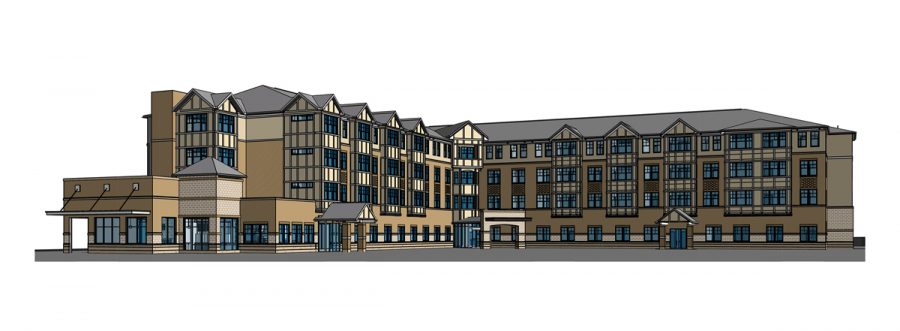Covenant Place readies for next phase of construction
Published April 13, 2017
Progress is continuing at Covenant Place with demolition for Phase II of its ongoing building program set to get underway this spring.
“What’s great about doing a second phase is that you have the opportunity to see people living in the first building and to see if things are working as they should, if they are serving people’s needs as they should and to do any little tweaks in the second,” said Joan Denison, executive director of the senior housing complex.
The first phase included construction of the Harry and Jeanette Weinberg Building, erected partially in the footprint of a bowling alley formerly owned by the Jewish Community Center. The Weinberg Building has been up and running since early last summer. Residents of the now-empty Covenant I building moved into the new building. Now, Covenant I will meet the wrecking ball with exterior demolition currently slated to begin in May.
Denison said Covenant I has five different sections, which must be taken down one-by-one.
“Obviously, it is not just a one-day thing to take down that size of a brick building,” she said.
After that, site preparation will begin including new sewer and gas lines as well as electrical work and grading of the topography. Denison believes vertical construction on the second building can begin this summer, with a probable completion date in early 2019.
The four-story edifice, which will be named in honor of the family of Paul and Elissa Cahn, will have 102 single-bedroom units spread across the upper floors. However, the ground level will include a unique “one-stop-shop” feature for residents and seniors of the surrounding community. Named in honor of Helene Mirowitz, the Mirowitz Center will provide spaces for various amenities and activities including a casual dining venue.
There will also be offices providing space to an array of organizations and groups that focus on programs for elderly residents such as Jewish Family & Children’s Service’s ElderLink program. RPI Therapy Services will have an expanded clinic in the building and there will be a visiting attorney, banking and medical services and Medicare navigators during open enrollment.
Not only that but additional space for classes or presentations will be available.
“We’ll be able to greatly expand and we’ve been reaching out to different partners in the community who do provide interesting classes and programs,” Denison said. “Our goal isn’t to be the producer of everything but to be the host for a variety of programs.”
The center will be open not just to residents but to the surrounding area that has been identified as a naturally occurring retirement community, known as a NORC. That’s part of the reason St. Louis County has been a strong supporter of the new construction.
“They made both phases of this project their priority to receive a very competitive low income housing tax credit award which is a significant source of funding for the project,” Denison said of county officials. “They’ve made a $300,000 grant to the senior center.”
Margie Guller Hartman, director of strategic operations, said that the idea is to promote interaction and involvement with both Covenant residents and those living in the NORC.
“We’re excited about the opportunity to provide a launching pad for other organizations to provide programs and services to older adults,” Hartman said. “Keeping prices down [at the café] and getting people in is a great way to get them to come here and say, ‘Look, there is going to be exercise’ or ‘Look, there’s going to be a movie or a speaker I’m really interested in.’ ”
Expected to run about $85 million, the three-building project is mostly supported by mortgages, tax credits and grants from local and state government with about 30 percent coming from fundraising.
If all goes according to plan, Phase III will go up in the hole left by the demise of the Covenant II building. The most resident-heavy structure, it would contain about 150 units which, like those in the other buildings, would have ample room for turning radius for those with mobility issues as well as bathroom fixtures that accommodate the disabled.
“The apartments are universally designed,” Denison said. “That means I might move in and I’m physically well and capable but over the years that I live there maybe I’ll need a walker, a wheelchair or scooter. You can continue to live in that apartment.”
The final building could be done as soon as 2021 or 2022 if fundraising permits. If completed, it would allow the extension of a substantial number of Housing and Urban Development contracts for the next two decades.
It will also leave an open spot on the campus that could be utilized for any number of purposes after all of Covenant’s 400 or so residents are finally settled in. Denison said that will likely be part of a future discussion.
“It is an interesting opportunity as we move through this project,” she said. “It creates an opening for what our community needs are and what makes sense to have on the Millstone Campus.”
















